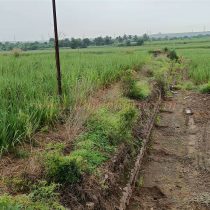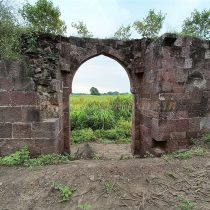AMDABAD
TYPE : FORTRESS
DISTRICT : PUNE
HEIGHT : 0
While wandering through the Pune and Nagar districts, you can explore many forts along the border of both districts. Some forts in this region are well-known, while others remain completely unknown. The Parmar, also known as Pawar, dynasty, originally from Shivaji Maharaj’s time in the Malwa region of North India, had numerous forts and fortresses both within Maharashtra and beyond. One such Pawar fort can be found in the village of Ahmadabad in the Shirur taluka of Pune district. Ahmadabad village is located approximately 14 km from Shirur taluka and it is around 60 km from Pune city. Even though not much information is available about the fort in the village, you can easily reach it by exploring the riverside temple. Two memorials (memorials) are built on a rock platform 10 feet above the riverbed. One memorial is octagonal, and the other is square.
...
The square-shaped memorial resembles Rajaram Maharaj's memorial on Sinhagad, with a lotus flower carved on it. To reach both memorials, you have to climb 15 steps built in finished stones. Inside of one memorial houses a Shivlinga, while the other memorial is open. Both memorials have a river valley behind it. On watching this memorial you will easily understand that these memorials are built for the person from royal family. On the upper side of the valley we can see the fortifications of the fort and the door. First we should explore the river valley, in here there is a well for drinking water. On the side of the valley, a cistern is present for performing religious rituals. Water from the well flows into the cistern and fort through a channel for supplying water. As we move forward we see two bastions and 2 horse faces & Ganesh idol fitted in window of these bastion. The fort's entrance, located in the middle of rampart facing toward north side riverbank, is well-preserved, and its arch can still be seen. The bastion of the fort is built on a rock, and it is 8 to 10 feet high. However, in some places, the edge of the riverbank has collapsed. As agriculture is practiced in the fort's vicinity, the remains of the fort are completely covered with soil. Due to this, the fort has lost its identity. Your trek to the fort is completed after you go around this place. You can find another memorial and a stone wheel near the village. It is essential to visit this fort located in the picturesque river bank. The Parmar dynasty, ruling in the Malwa region of Central India, established their lineage in this region around 1305 AD after the invasion by Aladdin Khilji. The descendants of the Parmar dynasty, who ruled in Dhar after laying low for a while, migrated to various regions. One branch of this dynasty came to Maharashtra, and the Pawar emerged as leaders. The ancient capital Dhar, from where this dynasty originated, became famous in history as Dhar Pawar due to its connection with the Shivaji Maharaj era. Shambhusingh Pawar, also known as Sabusingh Pawar, is considered the founder of this dynasty. In 1658, when Shivaji Maharaj obtained Kalyan, Sabusingh Pawar was with him. Sabusingh had a son named Krishnaji. Due to the circumstances of Afzal Khan's death, Fazal Khan became involved with Krishnaji Pawar, who fought valiantly and defeated the Mughals. Krishnaji Pawar's name spread after his valiant fight alongside Shivaji Maharaj. After the death of Krishnaji Pawar, his three sons, Buvaji, Rayaji, and Keroji, joined Shivaji Maharaj's army. Buvaji Pawar fought fiercely against the Mughals, securing and occupying several forts. Buvaji Pawar and Keroji Pawar played a significant role in strengthening the Maratha Empire. In recognition of their services, Buvaji Pawar received the title of Vishwasrao and Keroji Pawar was appointed the commander-in-chief. Balvantrao Pawar, a descendant of this lineage, was stationed in Amadabad & he built the fortress of Amadabad.
© Suresh Nimbalkar



























